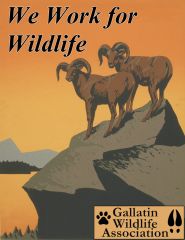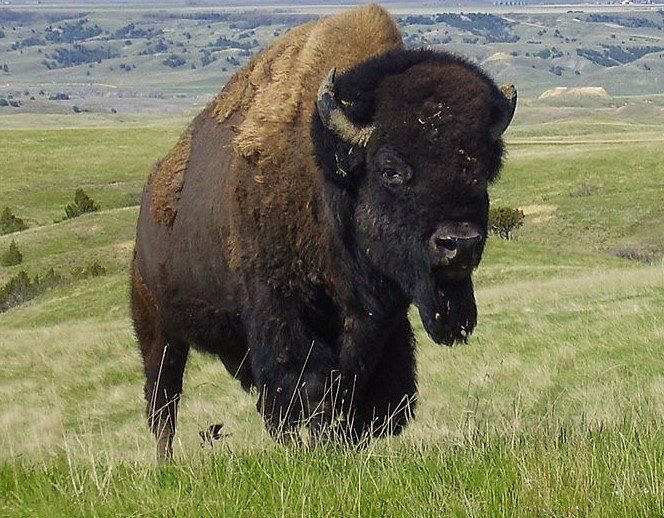Welcome to the
Gallatin Wildlife
Association
Website

Welcome to the
Gallatin Wildlife
Association
Website
Our Strategy On Bison
Our Strategy on Bison:
The Gallatin Wildlife Association's main goal concerning bison is to get free-roaming bison on public land, outside the boundary of Yellowstone National Park. Currently bison from Yellowstone National Park have a history of roaming out of the park during the late-winter months for warmer temperatures, less snowpack, and early-greening forage - trying to find their normal late-winter range. As a result bison are intensively hunted or captured and slaughtered, never having a chance to get firmly attached to the public landscape within Montana and outside the Park boundary. For more information on GWA's position, please see the links above or read the articles below.
Our letter to Secretary Deb Haaland-
March 24, 2023
Re: Migration of Bison from Yellowstone National Park
at Beattie Gulch
Office of the Secretary of the Interior
Department of the Interior
1849 C Street, N.W.
Washington D.C. 20240
Dear Secretary Deb Haaland:
We assume you are aware of the decades of controversy over the annual migration of bison from the northern boundaries of Yellowstone National Park (YNP). Depending upon the severity of winter months, December through March, this annual migration ends in bloodshed for hundreds to thousands of Yellowstone National Park bison. The moment bison migrate out of the park beyond an “invisible fence line,” the killing begins at a location known as Beattie Gulch, a small acreage of US Forest Service land immediately outside the park boundary near Gardiner, Montana.
Since year 2000, a formulation of multiple agencies, federal, state, and tribal, have been wrangling over the best bison management policy under the auspices of the Interagency Bison Management Plan (IBMP). As you know, the IBMP was originally negotiated and signed by a previous Secretary of Interior. However, it has become apparent over the years, the interagency compact has led to bitter feelings, as the federal, state, and tribal governments have conflicting goals and missions.
The systematic killing and culling of YNP bison at Beattie Gulch, a practice the IBMP has condoned each year, has run into a 21st century ethical nightmare. The practice has not proven successful for bison ecology or safe for the general public, residents, or for those who participate in the annual hunt itself. This is why we think it best if you intercede. Perhaps it is the only way to restore bison migratory behavior outside of YNP and bring a sense of regulatory order and safety to the Gardiner community. We encourage you, as Secretary of Interior, to involve yourself in the negotiation process. We urge you to meet with tribes, perhaps the Secretary of Agriculture and Chief of the U.S. Forest Service, in order to renegotiate how their treaty rights should be enforced in a modern society.
The hunt which is administered by eight sovereign nations and the state of Montana has been proven to be a poor model of conservation. Yet it threatens to expand, incorporating more tribes in the future. It breeds competition among hunters and tribes to seek what they think is a fulfillment of their treaty rights negotiated with the federal government. If hunting were to cease or be drastically reduced at Beattie Gulch, bison survivors would be able to roam, explore, and instill possible memories of where they may find springtime forage. This could very well benefit their decision-making processes in the future, for at present treaty hunting is preventing migratory behavior, an important aspect of bison ecology.
This winter appears to be one of the worst among the worst as far as the number of projected bison deaths. The latest updated records of March 18, 2023 indicate the number of bison killed and culled from the northern boundary alone at 1,398, with another 374 bison in holding. This brings the total number of bison removed from the northern boundary at 1,772, 31%, nearly a third of the total population. YNP’s own scientists recommend reducing bison numbers by no more than 25% in order to avoid “altering the population composition and reducing the genetic diversity.” As you see, we are already surpassing that marker. Other observers fear and believe the number of bison killed from the Northern boundary are much higher than that being reported.
Gallatin Wildlife Association (GWA), located in Bozeman, Montana, is a local, all volunteer wildlife conservation organization dedicated to the preservation and restoration of wildlife, fisheries, habitat and migration corridors in Southwest Montana and the Greater Yellowstone Ecosystem, using science-based decision making. We are a nonprofit 501(c)(3) organization founded in 1976. GWA recognizes the intense pressures on our wildlife from habitat loss and climate change, and we advocate for science-based management of public lands for diverse public values, including but not limited to hunting and angling.
The long-term goal of GWA has been to achieve free-roaming bison on public land outside of Yellowstone National Park, but that goal will never be achieved as long as bison are consistently removed under the program of today. Bison are killed and culled before they have a chance to promulgate on public land. The Custer Gallatin National Forest has the availability and habitat to be used as winter-feeding grounds during harsh winter months.
We should let science dictate good policy with conservation ethics being the guardrails of the policy’s implementation. That is not the current practice. While the killing continues, the U.S. Fish and Wildlife Service is reviewing the petitions to have the Yellowstone National Park bison defined as a “Distinct Population Segment” worthy of protection under the Endangered Species Act. As signatory to the original plan and the federal official tasked to represent the United States in managing treaties with tribal nations, you are the best person to resolve the ongoing challenges of protecting wild bison and influencing the actions of the tribes engaging in the harvest of Yellowstone bison.
The current practice diminishes the reputation of all parties involved, and all the while the bloodshed from killing defenseless bison flows deeper and redder than ever. This is our Nation’s Mammal, yet we are allowing these herds to be decimated, suffering, and injured, while at the same time, many officials seem to behave in willful ignorance to the severity of the problem. There is nothing natural and scientific about the current practice. There must be a willingness of all parties to be part of the solution. We firmly believe you could help develop a better, more scientific approach in bison management should you choose to do so.
Thank you for your time and consideration in this matter. We look forward to seeing a resolution to this problem in the future.
Sincerely,
Clinton Nagel, President
Gallatin Wildlife Association
For specific papers on Bison use these links or the links above with the same title.
1. Plains Bison - The Forgotten Species
https://www.gallatinwildlife.org/plains-bison---the-forgotten-species
2. Restoration and Management of Wild Bison in Montana
https://www.gallatinwildlife.org/positions-on-restoration-and-management-of-wild-bison-in-montana
Montana Bison Restoration Coalition:

If there be no place for wild bison
in all Montana,
then surely we have crossed a line
between the last best place
and the once best place.
Picture provided by Dr. Jim Bailey, author unknown.
MISSION STATEMENT:
The Montana Bison Restoration Project aims to enhance public awareness of conservation opportunities for wild, public bison in our state; and to establish a bison herd on public land and private land where bison are accepted, within and near the Charles M. Russell National Wildlife Refuge.
THE COALITION:
The Montana Bison Restoration Coalition consists of individuals and organizations – conservationists, sportsmen and women, landowners and wildlife biologists – dedicated to returning genetically adequate numbers of wild bison to the state. We encourage respectful, public conversation with all stakeholders.
GOALS:
MONTANA BISON:
Currently, there is no herd of wild bison, year-round, in Montana.
In 2009, Fish, Wildlife & Parks initiated planning for reestablishing bison. A limited proposal that did not identify a reintroduction site, was developed in 2015, but there has been no decision to proceed.
Bison free of serious diseases that may pass to cattle are available from several sources for this project. FWP has rights to such bison now being cared for at Forts Peck and Belknap Reservations.
Bison in Yellowstone National Park are the only truly wild population of plains bison in the United States. The CMR National Wildlife Refuge is the best location in the country for establishing a second wild herd.
PARTICIPATE:
For more information, please contact this website: http://www.mtwildbison.org
or contact: jabailey34@aol.com

To Contact Us, either contact us directly using this address or using the link button below.
Contact Details:
Gallatin Wildlife Association
P.O. Box 5317, Bozeman, MT 59717
“To restore stability to our planet, therefore, we must restore its biodiversity, the very thing we have removed. It is the only way out of this crisis that we ourselves have created. We must rewild the world!”―David Attenborough